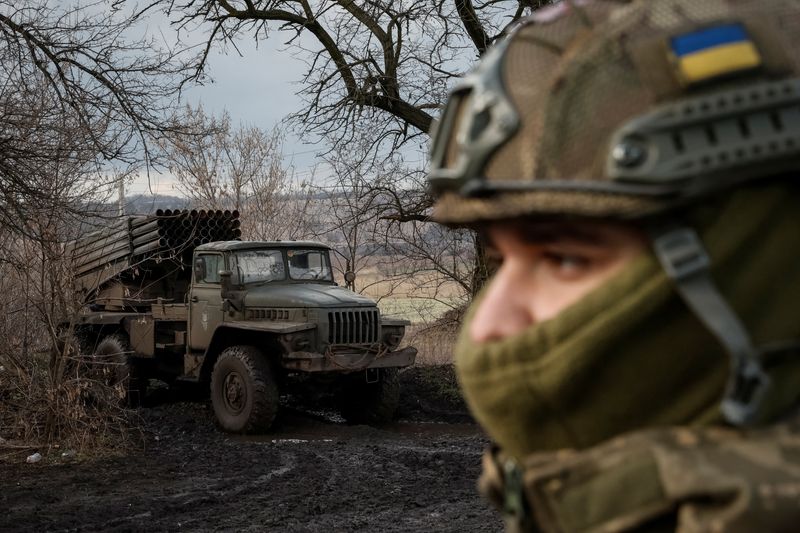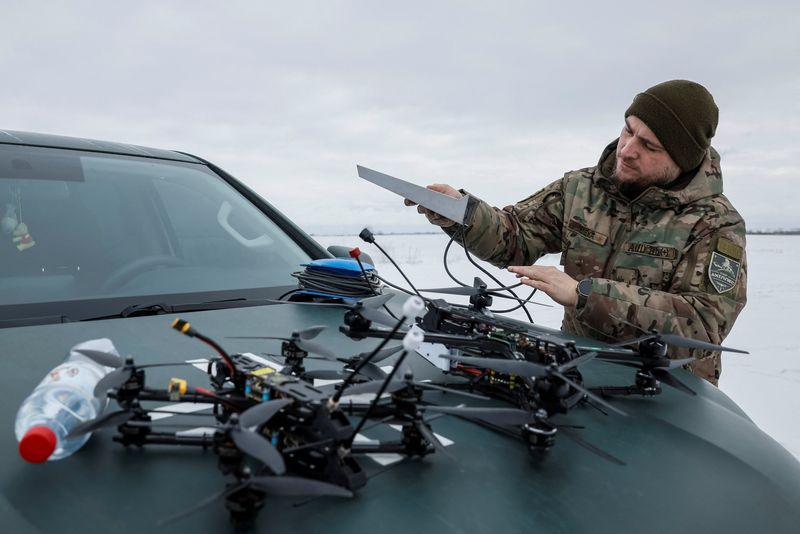By Max Hunder
KRAMATORSK, Ukraine (Reuters) - As the Ukraine war enters its third year, the infantry of 59th Brigade are confronting a bleak reality: they're running out of soldiers and ammunition to resist their Russian invaders.
One platoon commander who goes by his call sign "Tygr" estimated that just 60-70% of the several thousand men in the brigade at the start of the conflict were still serving. The rest had been killed, wounded or signed off for reasons such as old age or illness.
Heavy casualties at the hands of Russian forces have been compounded by dreadful conditions on the eastern front, with frozen soil turning into thick mud in unseasonably warm temperatures, playing havoc with soldiers' health.
"The weather is rain, snow, rain, snow. People get ill with simple flu or angina as a result. They're out of action for some time, and there is nobody to replace them," said a company commander in the brigade with the call sign "Limuzyn". "The most immediate problem in every unit is lack of people."
On the cusp of the second anniversary of its Feb. 24 invasion, Vladimir Putin's Russia is in the ascendancy in a conflict that combines attritional trench combat reminiscent of World War One with high-tech drone warfare that's sending tens of thousands of machines into the skies above.
Moscow has made small gains in recent months and claimed a major victory at the weekend when it took control of Avdiivka in the hotly contested eastern Donetsk region. A spokesperson for 3rd Separate Assault Brigade, one of the units that tried to hold the town, said the defenders were outnumbered seven to one.
Reuters spoke to more than 20 soldiers and commanders in infantry, drone and artillery units on different sections of the 1,000-km frontlines in eastern and southern Ukraine.
While still motivated to fight Russian occupation, they spoke of the challenges of holding off a larger and better supplied enemy as military support from the West slows despite pleas for more from Ukrainian President Volodymyr Zelenskiy.
Another commander in the 59th Brigade, who only gave his first name Hryhoriy, described relentless attacks from groups of five to seven Russian soldiers who would push forward up to 10 times a day in what he called "meat assaults" - highly costly to the Russians but also a major threat to his troops.
"When one or two defensive positions are fighting off these assaults all day, the guys get tired," Hryhoriy said as he and his exhausted men were afforded a brief rotation away from the frontlines near the Russian-occupied eastern city of Donetsk.
"Weapons break, and if there is no possibility of bringing them more ammunition or changing their weapons, then you understand what this leads to."
Russia's defence ministry didn't respond to a request for comment on the state of play on the frontlines.
Ukrainian Deputy Defence Minister Ivan Havryliuk told Reuters that Ukraine had been forced onto the defensive by a lack of artillery ammunition and rockets, and that Kyiv was expecting Russia to intensify its assaults on several fronts.
"If there are further delays to the necessary military aid, the situation on the front could become even more difficult for us," he said in a written response.
WANTED: FIGHTERS AND AMMO
Kyiv relies heavily on money and equipment from abroad to fund its war effort, but with $61 billion in U.S. aid held up by political bickering in Washington it is looking more exposed than at any time since the start of the invasion.
A soldier serving in a GRAD rocket artillery unit, whose call sign is "Skorpion", said that his launcher, which uses Soviet-designed ammunition held by few of Ukraine's allies, was now operating at about 30% of maximum capacity.
"It became like this recently," he said. "There aren't as many foreign munitions."
Artillery shells are also in short supply as a result of Western countries' inability to keep up the pace of shipments for a drawn-out war. On top of the U.S. supply pause, the EU has conceded it will miss its target to supply a million shells to Ukraine by March by nearly half.
Michael Kofman, a senior fellow and Russian military specialist at the Carnegie Endowment for International Peace, a Washington-based think-tank, estimated that Russia's artillery was firing at five times the rate of Ukraine's, a figure that Hryhoriy of the 59th Brigade also gave.
"Ukraine is not getting a sufficient amount of artillery ammunition to meet its minimum defensive needs, and this is not a sustainable situation moving forward," Kofman added.
Moscow now controls almost a fifth of Ukrainian territory including the Crimea peninsula it annexed in 2014, even if the frontlines of the war have largely stagnated in the last 14 months.
Ukrainian officials have said their armed forces number around 800,000, while in December Putin ordered Russia's forces to be increased by 170,000 troops to 1.3 million.
Beyond personnel, Moscow's defence spending dwarfs that of Ukraine. In 2024 it earmarked $109 billion for the sector, more than twice Ukraine's equivalent target of $43.8 billion.
A new law aimed at mobilising 450-500,000 more Ukrainians is slowly making its way through parliament, but for some soldiers fighting now, significant reinforcements seem a distant hope.
Ukrainian Defence Minister Rustem Umerov recently referred to Ukraine's artillery ammunition deficit as "critical" in a letter to the European Union, urging its national leaders to do more to bolster supplies.
His letter said Ukraine's "absolute critical daily minimum requirement" was 6,000 artillery shells, but his forces were able to fire just 2,000 a day, the Financial Times reported.
DRONE WAR ON MASSIVE SCALE
Conventional warplanes are a relatively rare sight over the frontlines, largely because air defences act as a deterrent. Yet a different battle is raging in the skies, with both sides striving for the upper hand in drone technology.
Drones - or unmanned aerial vehicles (UAVs) - are cheap to produce and can surveil enemy movements and drop ordnance with pinpoint accuracy.
Kyiv has overseen a boom in drone production and innovation and is developing advanced, long-range UAVs, while Moscow has more than matched its rival with huge investments of its own, allowed it to nullify Ukraine's early advantage.
The scale is astonishing.
On the Ukrainian side alone, more than 300,000 drones were ordered from producers last year and more than 100,000 sent to the front, digital minister Mykhailo Fedorov told Reuters.
A strong focus now is on light, nimble FPV drones, where operators, or pilots, get a first-person view from an onboard camera. President Zelenskiy has set a target for Ukraine to produce one million FPV drones this year in light of the battlefield advantages delivered by the technology.
Limuzyn, the company commander in the 59th Brigade, said Russia's widespread use of drones had make it difficult for Ukrainian troops to establish or strengthen fortified positions.
"Our guys start to do something, a drone sees them, and a second drone arrives to drop something onto them."
Drones have also forced the Russians to move valuable vehicles and weapons systems back by several kilometres, according to two Ukrainian drone pilots in different units.
"It's now very hard to find vehicles to hit... most vehicles are 9-10 km away or more," said a pilot in the 24th Brigade with the call sign "Nato". "At the beginning they were very comfortable being 7 km away."
Two other Ukrainian drone pilots, "Leleka" and "Darwin", both serving in the elite Achilles drone unit of the 92nd Brigade, described queues of two or three UAVs sometimes forming above the battlefield, waiting to hit enemy targets.
Leleka recalled watching four drones from different Ukrainian units coming in to strike a target on one occasion: "It's like taxis at the airport, one drone comes, then another, then a third."
The same situation is true for the Russians, whose drones now comfortably outnumber Ukraine's, according to Ukrainian pilots from three units. The Russian defence ministry said this month that the country had ramped up its production of military drones in the past year, without giving figures.
As the use from drones grows, both sides are bolstering deployment of electronic warfare systems which can disrupt the frequencies that feed commands from the pilot to the drone, making them drop out of the sky or miss their target.

Darwin, a 20-year-old who dropped out of medical school to enlist when Russia invaded, compared the current drone arms race to that between aviation and air defence: planes dominated in World War Two, but modern air defence systems greatly limited their use in this war, he said.
"In future, I am sure there will be an analogous situation with drones: The concentration and effectiveness of electronic warfare will become so big that any connection between an aerial vehicle and its pilot will become impossible."
